Menus
- Racing history with 120-degree V2
- Destroyed Moto Guzzi 500 Bicilindrica
- Bicilindrica is still suitable for racing today?
- Pilot and bike form a unit
- Smooth and cultivated run of the Guzzi-V2
- Squeeze V2 up to the 8000 mark
- Performance instead of handling
- Technical specifications
- Contact
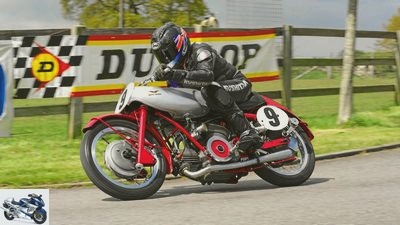
Nakamura
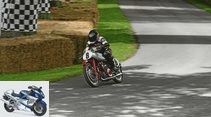
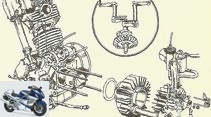
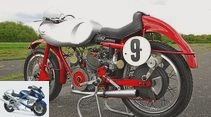
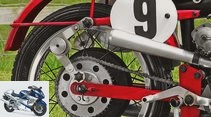
10 photos
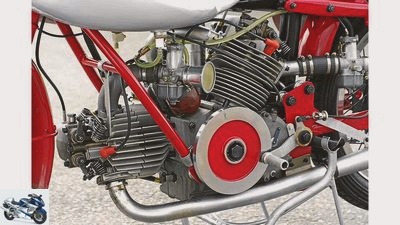
Nakamura
1/10
The open hairpin springs of the grandiose 120-degree V2 don’t drool around with oil.
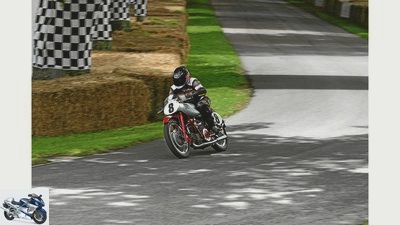
Nakamura
2/10
The version from 1948 surprised with a new fork.
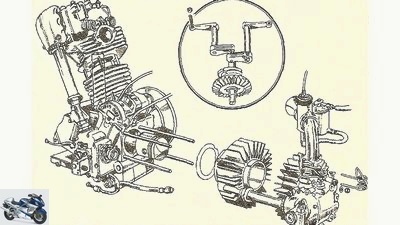
Nakamura
3/10
Pioneer: cultivated running V2 – thanks to the offset connecting rods mounted on the crankshaft. 50 years before the Honda V-Twins.
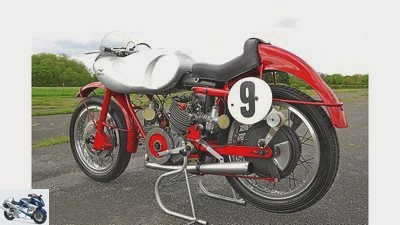
Nakamura
4/10
The distinctive tank hollows offer perfect space to accommodate the driver’s forearms and knees in an aerodynamically favorable manner.
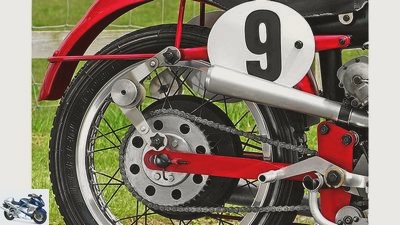
Nakamura
5/10
With the adjustable friction dampers on the rear wheel, the Bicilindrica stood out from the competition.

Nakamura
6/10
First public appearance at Goodwood Festival in front of 140,000 fans.

Nakamura
7/10
The rear cylinder appears to be hammering directly towards the most sensitive part of the pilot.
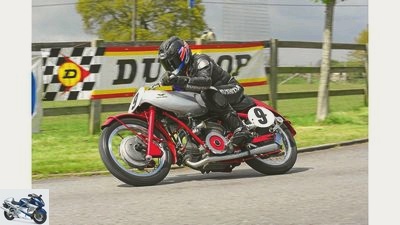
Nakamura
8/10
With its 120-degree V2, the Bicilindrica anticipated the later successful basic concept of Ducati’s 90-degree V2.

Nakamura
9/10
Three warriors with a history: author Alan (left), Sammy and the Moto Guzzi Bicilindrica.
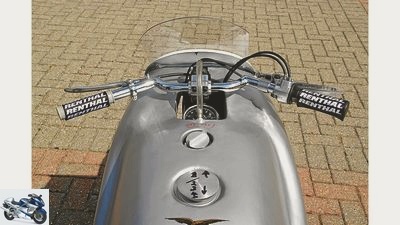
Nakamura
10/10
The flat handlebars protrude from the tank panel, which is pulled far forward, as if coming out of nowhere.
Moto Guzzi 500 Bicilindrica
Racing history with 120-degree V2
Content of
The Moto Guzzi 500 Bicilindrica made racing history during its nearly two-decade career. With her 120 degree V2 she anticipated the later successful basic concept of Ducati’s 90 degree V2 for a long time.
You shouldn’t mourn missed opportunities. And yet the thought comes to mind what is all about the Moto Guzzi 500 Bicilindrica could have become if the concept of the racing machine had been further developed for use in production motorcycles. So it remained with only about a dozen copies built, which stirred up the racing scene in the 1930s and 1940s. Even against later much more motorized opponents.
Destroyed Moto Guzzi 500 Bicilindrica
Today it has become almost impossible to even see the Italian racing legend, let alone hear it or even experience it in action. The 500 copy from around 1947 in the factory museum in Mandello del Lario is unfortunately never running. So I’m all the happier to be able to drive one of the rare, ready-to-drive bikes that Sammy Miller recently got hold of for his legendary museum. Almost in a double pack together with the equally legendary Moto Guzzi V8 racing machine.
Sammy found the two treasures from a private collector, where they practically slumbered in secret for many years. Actually an impossibility, after all, when the company officials officially withdrew from racing in 1957, they ordered that all factory racers be destroyed. Except for one of each type that should end up in the museum. But as Italians are, says Sammy, the racing bikes weren’t destroyed, just dismantled. The individual parts then disappeared in all directions and only found their way back together gradually, captured by busy hobbyists and collectors who screwed the factory racers back together. From such a collector near the Moto Guzzi factory in Lecco, after tough negotiations lasting 18 months, Sammy had acquired these two Guzzis.
Bicilindrica is still suitable for racing today?
How did this legendary machine come about? A quick look back: Moto Guzzi had a tough time in the 500cc class in the early 1930s. The outdated four-valve engine (from 1924) and the supercharged in-line four-cylinder engine developed as a result could not prevail in the fight against the single-cylinder Nortons (without supercharging) – a new concept was needed. At the right time, Carlo Guzzi had one of his brilliant ideas: In the 250cc class, the TT 250 has been dominating events for years without any risk. So why not couple two of these excellent engines and put them together to form a 500cc engine? The lying front cylinder was retained, the rear one docked at an unusual angle of 120 degrees, creating a V2, both of which had cylinders that were easy to cool and which also helped to preserve the low height of the motorcycle.
In the beginning, the heads and cylinders were made of gray cast iron, while the crank and gear housing were made of light metal. Soon, however, the former were also made of light metal and the even lighter electron was chosen for the housing. The two valves per cylinder had double hairpin springs that did their job without disguise, and two 35-millimeter carburettors from Dell’Orto provided the right mixture. So the first two-cylinder from Moto Guzzi saw the light of day in 1933, which was to be a successful part of the 500cc class by 1951. And this despite the fact that it was a little less nimble than the British single-cylinder bikes and less powerful than the supercharged German and Italian rivals. How suitable is the Moto Guzzi 500 Bicilindrica for racing today? After the imminent first functional test on the former military airfield, which now regularly serves as a test track for the Miller Museum, I will have the great honor of driving the Bicilindrica at its first public appearance at the Goodwood Festival in front of 140,000 spectators.
Pilot and bike form a unit
In anticipation of the event, I swing my leg over the flat bike and take the extremely unusual, yet very comfortable sitting position. Thanks to the backward-sloping, height-saving second cylinder, you crouch down very low on the almost plush, upholstered bench, clearly bent forward towards the flat handlebars. Diving behind the small windshield of the Moto Guzzi 500 Bicilindrica is almost automatic, elbows and knees find space in the indentations of the 20-liter tank, which leads to an aerodynamically favorable driver posture. Although you automatically feel as a unit with the bike, the direct steering feel seems a bit contradictory because the rotation of the upper triple clamp is not visible, the flat, narrow Ace-style handlebars seem to sprout out of the voluminous tank fairing. The direct steering of the softly sprung, pushed short swing arm at the front is therefore all the more astonishing.
Nakamura
First public appearance at Goodwood Festival in front of 140,000 fans.
Despite the 19-inch front wheel, the Moto Guzzi 500 Bicilindrica also seems to require less leverage than, for example, the late competitor Norton Manx. Despite all the sensitivity and precision, the Italian remains very stable even in long, fast corners. Even the peculiar friction damper at the rear does not allow the Guzzi to bounce as stiffly and unwillingly as feared. She only tramples a little rough on rough transverse joints.
The Moto Guzzi 500 Bicilindrica does away with the prejudice that all V-Twins with a cylinder angle of 90 degrees or more are stubborn understeer. With its wheelbase of 1400 millimeters, the Guzzi waggles neatly through tight chicanes, whereby the driver can save himself penetrating hanging-off to avoid touching down – the 500 prefers the classic, upright driving style. The driver should only pay attention to the tip of his left foot to avoid coming into contact with the exposed flywheel. On the right-hand side, the oil pump sits tiptoe in the way when changing gears – downshifting requires (because of the reversed shift pattern) a firm step with the heel on the rear arm of the rocker switch. Shifting without using the clutch is not possible at all.
Smooth and cultivated run of the Guzzi-V2
Of course, the driver should not interconnect in general and in particular with the Moto Guzzi 500 Bicilindrica – the rear cylinder seems to be pumping up and down directly below, say, the most private parts of the driver – a high-speed engine is hard to imagine. Maybe that’s why the Italians designed the tube of the backbone frame so massive…
The wide-angled V2 reveals nothing brutal or brute, after all these years on various Ducati racers, the smooth, cultivated run of this Guzzi V2 is even more astonishing. The unrhythmic engine thundering out of the muffler lets expect something completely different, but the smooth running of the V-Twin degrades even the modern Ducati-V2 to a coarse jolting machine. The engine of the Moto Guzzi 500 Bicilindrica runs smoothly at idle at just 500 rpm, which can be read on the half-covered Smiths tachometer that peeks out of the front of the tank panel.
The clean run is also thanks to Sammy Miller‘s conversion to a 28 mm Bing carburetor. “The 250 had 30-millimeter carburettors, but with the coupling of two singles to the V2, they mounted 35,” says Sammy. “That means that the Moto Guzzi 500 Bicilindrica was actually over-equipped for its cylinder head design, and it was virtually impossible to get the gas flows under control and get a clean set-up.” I appreciate this optimization – this is how the 47 hp can be achieved at 8000 rpm, the ultimate expansion stage, appropriate to the species. Okay, over 5000 tours should already be there in order to find useful performance, at around 3000 rpm it still spurts a little out of the megaphone pots.
Squeeze V2 up to the 8000 mark
Moto Guzzi accepted a narrower rev range in favor of higher peak performance in order to make the Moto Guzzi 500 Bicilindrica capable of winning towards the end of its career. In view of the speed jump of 2300 tours between second and third gear, it is inevitable to squeeze the V2 up to the 8000 mark in order not to fall into a performance gap after the gear change. With the jump of just 700 revolutions between third and last gear, the four-speed gearbox is more geared towards high-speed slopes like Monza, so that on smaller, tighter courses, you are almost exclusively in the two middle levels.
By the way: Despite the hairpin springs used, which regularly ensure that the driver’s legs are completely covered with lubricant on a Norton Manx, the Guzzi driver always remains clean. Why did the Italians manage this and the English not? Strangely, not even Stanley Woods ‘legendary victory at the TT 1935 encouraged widespread imitation of the progressive Guzzi solutions by British competitors. Pride, arrogance, and false beliefs in traditional values arguably played a role in this response to Italian success.
Performance instead of handling
Rather, the competition in the second half of the 1930s degenerated into an exaggerated striving for more and more performance instead of improving handling qualities. More and more charged bikes appeared on the racing scene – the Moto Guzzi 500 Bicilindrica with its hard-won 47 hp (by increasing the rated speed) could hardly hold its own against the more than 80 hp bolides from BMW and Gilera as early as 1935. Only on winding courses, where the lighter, more manageable Guzzis had advantages, the Italians were able to achieve victories until the outbreak of the Second World War.
Nevertheless, a one-two victory in Monza was still enough in 1936, and at the end of 1937 the plant even put a charged, water-cooled bicilindrica prototype on its wheels, which, however, was never used in the race. The Moto Guzzi 500 Bicilindrica was still involved in racing until 1951, when it was over. From then on, they relied on an in-line four-cylinder, and ultimately even on the legendary eight-cylinder bike. Sammy Miller can also call the latter his own. But this is another story that will soon have to be told.
Technical specifications
Nakamura
The open hairpin springs of the grandiose 120-degree V2 don’t drool around with oil.
Engine: Air-cooled two-cylinder four-stroke 120-degree V-engine, one overhead camshaft per cylinder driven by vertical shaft, two valves each, bore x stroke 68 x 68 mm, 494 cm³, compression 9.5: 1, 47 hp at 8000 / min, two 28-millimeter Bing carburettors (trial version), Magneti Marelli magneto ignition, multi-disc oil bath clutch, four-speed gearbox, chain
Landing gear: Backbone frame made of tubular steel with beams, pushed short swing arm at the front, two-arm swing arm at the rear with adjustable friction dampers, wire-spoke wheels, tires 3.25 x 19 at the front, 3.50 x 19 at the rear, double simplex drum brake at the front, Ø 220 mm, simplex drum brake at the rear, Ø 220 mm
Measurements and weight: Wheelbase 1400 mm, weight 145 kg (without petrol)
Mileage: Vmax about 210 km / h
Contact
Nakamura
Auto Alan (left), Sammy and the Moto Guzzi Bicilindrica.
Sammy Miller Motorcycle Museum
Bashley, New Milton
Hampshire B25 5SZ
Telephone: 0044/14 25-62 07 77 or 61 66 44
www.sammymiller.co.uk
The Sammy Miller Museum is teeming with interesting machines such as the Moto Guzzi Bicilindrica on display, the V8 racing machine mentioned, numerous exhibits from Norton, AJS, Excelsior, Velocette and many more brands. Children can romp around in the new playground, and physical well-being is provided in the “tea rooms”.
The museum is now open daily from 10 a.m. Admission: 6.90 pounds (about 8.60 euros)
Related articles
-
Top test Moto Guzzi Stelvio 1200 4V
Bilski 10 pictures Moto Guzzi 1/10 Moto Guzzi 2/10 Moto Guzzi 3/10 Moto Guzzi 4/10 Moto Guzzi 5/10 Moto Guzzi 6/10 Moto Guzzi 7/10 Moto Guzzi 8/10 Moto …
-
In the studio – Moto Guzzi Condor
bilski-fotografie.de 18 pictures bilski-fotografie.de 1/18 Moto Guzzi Condor. bilski-fotografie.de 2/18 For reasons of performance, the original engine was …
-
On the move: BMW R 100 S, Honda CB 900 F Bol d’Or, Moto Guzzi Le Mans I.
fact On the move: Big Bikes of the 70s BMW R 100 S, Honda CB 900 F Bol d’Or, Moto Guzzi Le Mans I Contents of At the change of the decade, MOTORRAD asks …
-
Driving report Moto Guzzi Griso 8V
Bilski Driving report Moto Guzzi Griso 8V With two game four Moto Guzzi traditionally relies on two cylinders. Classically air-cooled, lying lengthways,…
-
Moto Guzzi V7 Special and Moto Guzzi V7 II Special in comparison test
fact 38 pictures fact 1/38 Moto Guzzi V7 Special and Moto Guzzi V7 II Special in a comparison test. fact 2/38 … the Moto Guzzi V7 II Special scores with …
-
Moto Guzzi California III put to the test
Archive Moto Guzzi California III under test Competition for Harley Co. With the California III, Moto Guzzi 1987 presented a classic tourer that …
-
Cagiva Elefant 650 and Moto Guzzi V 65 TT
markus-jahn.com 30 pictures markus-jahn.com 1/30 picture gallery: Cagiva Elefant 650 and Moto Guzzi V 65 TT on the move. markus-jahn.com 2/30 Cagiva Elephant …
-
Top test Moto Guzzi Breva V 1100
Jahn Top-Test Moto Guzzi Breva V 1100 Brave Breva With the Breva V 1100 a new era begins for Moto Guzzi. And for BMW grows for the first time …
-
On the move with the BMW R 100 RS, Kawasaki Z 900 and Moto Guzzi 850 Le Mans
Rivas 39 pictures Arturo Rivas 1/39 The old controversial question of what makes really fast has moved bikers for generations: high performance, good aerodynamics or …
-
On the move: Moto Guzzi California
Moto Guzzi On the move: Moto Guzzi California and California Vintage California Dreams Contents of In the 70s, the Beach Boys intoned a …